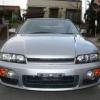Intercooler Water Spray - Trigger Point
Intercooler water spray trigger point
22 members have voted
Announcements
-
Similar Content
-
Latest Posts
-
By soviet_merlin · Posted
Hmmm, what do you mean by getting weaker? And where did you get that test done? I've been wondering about my battery because the cold starts crank super slowly. The voltage is fine. Not sure if cranking amps can be checked at home. Battery is 4+ years old. -
No. The simplest wastegate hookup, with no solenoid or other form of "boost control" (ie, control over your boost control, if you know what I mean) is a single hose, direct from the turbo outlet/hot pipe, straight and only to the wastegate actuator. It is that pressure signal that drives the wastegate to open, providing the boost control (and by "boost control" here, I mean, limiting how high it can go, which is essentially the spring pressure of the actuator). You only end up with tee pieces and alternate flow paths once you start adding things to the boost control system to allow you to determine how much of that boost signal makes it to the actuator. There are so many ways to do that that there is no single way to run the hoses and tees and the like. If you have a stock boost solenoid, then all it does is either allow all the boost signal to go to the actuator, or open up to allow some of it to bleed off. There needs to be a restriction in that bleeder to allow only a small amount to bleed off. And in a stock system, that would then be plumbed back to the turbo inlet (for "emissions control" reasons). That is actually what that nipple on your BOV return pipe could/would be for. If you have an aftermarket boost controller and solenoid, then the above is mostly true, but there is no need for a restrictor in the bleed, because the solenoid is pulse width modulated to create a variable bleed off. The air that escapes from the bleed can either be vented, or also returned to the turbo inlet. For emissions reasons it should be returned to inlet, but the amount of air being vented is so small that it really doesn't matter (either from an emissions perspective, or from an air-fuel ratio affecting perspective).
-
And other times you just need to go buy bigger injectors?
-
By thatjawncrazy · Posted
Yup. I actually just blew my turbo. LOL. should have checked this thread before today. i also have no boost solenoid. so it should be...one line from wastegate to turbo inlet, and a T somewhere in that line that connects to the wastegate return pipe? -
By Dose Pipe Sutututu · Posted
It's recommended, however I can assure you a good amount of people don't bother. FWIW, the OEM battery lasted 4.5 years and I changed it prematurely too, I reckon could have stretched it to 5 years.
-









Recommended Posts
Create an account or sign in to comment
You need to be a member in order to leave a comment
Create an account
Sign up for a new account in our community. It's easy!
Register a new accountSign in
Already have an account? Sign in here.
Sign In Now